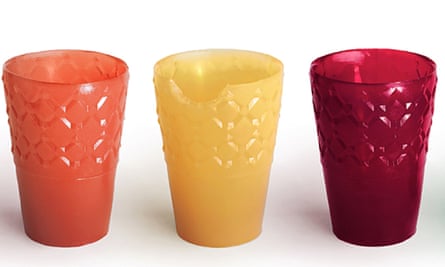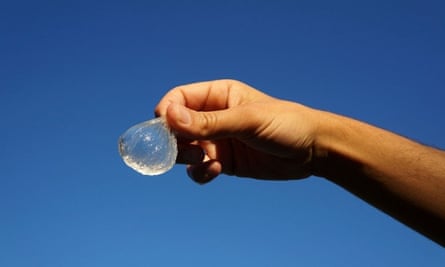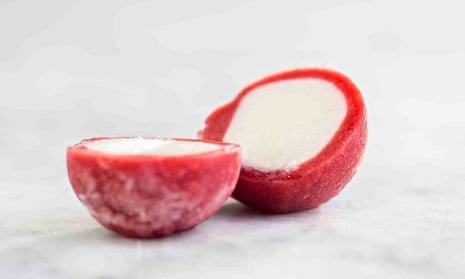If Willy Wonka did packaging, it’d probably look something like the WikiPearl – a soft, durable and water-resistant edible membrane, made from natural food particles, designed to protect a bite-size portion of food that it’s encasing. Created by David Edwards, a Harvard professor and biomedical engineer, the intention of the WikiPearl (formerly WikiCell) is to kill the packaging and make its relationship with food symbiotic.
“It’s important we don’t only look at this as a way to reduce plastics in packaging, but also in the context of how nature creates its own biodegradable packaging, like the skins of fruits,” says Eric Freedman of WikiFoods. The company, based in Cambridge, Massachusetts, has collaborated with the organic dairy business Stonyfield to apply the WikiPearl technology to yogurt. The Frozen Yogurt Pearls (think, small scoops of ice cream) come in coconut, peach and strawberry flavoured skins and are being sold at selected Whole Foods stores in the US.
According to the government’s waste advisor Wrap, households in the UK threw out 4.2m tonnes of food and drink waste in 2012. Rethinking packaging is a popular topic of conversation for sustainability wonks and designers. Recently, the Swedish duo Tomorrow Machine showcased a series of utopian packaging that included a container that dissolves with its contents. They have previously designed a wrapper that transforms into a bowl when water is poured on it. Tomorrow Machine’s founders admit that it will be a several years before such concepts are adopted commercially, so while we wait to be able to wash our packaging down the sink with plate scrapings, we’re encouraged to masticate as well as reduce, reuse, recycle.
Loliware is a New York start up that has developed a range of colourful, edible cups made from agar, a vegetarian substitute for gelatine. Frustrated by the amount of disposable packaging that is thrown away (in the UK, around 2.5bn cups go to landfills each year) and inspired by their love for Jell-O, its founders Chelsea Briganti and Leigh Ann Tucker have taken a novel, cradle-to-cradle approach to reducing waste.
“Our solution is to eat the cup, because they’re fun and they taste great [current flavour on sale is citrus], or just compost them. Either way, you’re contributing to the solution, instead of the plastic problem,” says Briganti, who is confident that they can get more people thinking about reducing their waste.

Last year, three students from Imperial College London designed an edible water bottle, the Ooho, using a similar technique applied by David Edwards – spherification. They have a desire to cut the number of plastic bottles being used every day. Initial demonstrations suggest drinking it is messy and slightly impractical, but the membrane holding the water, made from brown algae, is biodegradable.
Getting the Ooho to market could be a complex endeavour. The engineering of the membrane may need to be refined, along with how they’d appear on supermarket shelves – “the distribution and display would be similar to the way we buy fruits,” says Rodrigo Garcia Gonzalez, one of its creators – and then there’s the issue of how it feels in the mouth. “It’s a gelatinous texture that we are not used to,” admits Gonzalez, adding that while the membrane is tasteless some people who have tested it preferred not to eat it.

The packaging industry acknowledges that there’s a psychological barrier to eating packaging, particularly in regards to aesthetics. For example: bits of a membrane stuck between teeth or bits of cup floating in a drink. A combination of not wanting to alienate consumers and food safety regulations means that Loliware’s cups and WikiFood’s yogurt pearls are currently sold in eco-friendly packaging. While Loliware aspires to market its product in edible boxes, WikiFoods’ ambition is to go container-free and for the pearls to be sold a bit like sweets in a pick’n’mix aisle. “It could be a served bar situation, like a gelato bar, or a bulk option in the freezer where consumers can fill their own containers,” adds Freedman.
There’s also the issue of hygiene to be navigated; sceptics are likely to be concerned about possible contamination. WikiFoods believes that this is simply because people aren’t used to seeing certain products that are normally packaged out of their wrapping.
“I would politely ask [any concerned person] what they do with their apples and other produce when they take them home. I assume they wash them. Which is what you can do with a WikiPearl,” explains Freedman. “Or what do they do when they take bagels, scones or muffins from the bakery racks? They use tongs or a piece of wax paper to place it in a container.”
Ultimately, as it always is in business, the longevity of edible packaging will be down to how all this translates into sales. Loliware and WikiFoods have had relatively good success since launching their products this year, but whether people will have an appetite for edible technology as the future of sustainable packaging is yet to be determined.
Read more like this:
- Berlin duo launch a supermarket with no packaging
- Disney World’s biogas facility: a model for converting food waste into energy
- Advertisement feature: Recycling: ‘the loop of last resort’ within a circular economy
The circular economy hub is funded by Philips. All content is editorially independent except for pieces labelled advertisement feature. Find out more here.
Join the community of sustainability professionals and experts. Become a GSB member to get more stories like this direct to your inbox

Comments (…)
Sign in or create your Guardian account to join the discussion